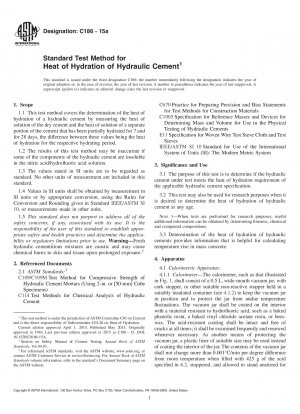ASTM C186-15a
Standard Test Method for Heat of Hydration of Hydraulic Cement
- Standard No.
- ASTM C186-15a
- Release Date
- 2015
- Published By
- American Society for Testing and Materials (ASTM)
- Status
- Replace By
- ASTM C186-17
- Latest
- ASTM C186-17
- Scope
3.1 The purpose of this test is to determine if the hydraulic cement under test meets the heat of hydration requirement of the applicable hydraulic cement specification.
3.2 This test may also be used for research purposes when it is desired to determine the heat of hydration of hydraulic cement at any age.
Note 1: When tests are performed for research purposes, useful additional information can be obtained by determining fineness, chemical and compound compositions.
3.3 Determination of the heat of hydration of hydraulic cements provides information that is helpful for calculating temperature rise in mass concrete.
1.1 This test method covers the determination of the heat of hydration of a hydraulic cement by measuring the heat of solution of the dry cement and the heat of solution of a separate portion of the cement that has been partially hydrated for 7 and for 28 days, the difference between these values being the heat of hydration for the respective hydrating period.
1.2 The results of this test method may be inaccurate if some of the components of the hydraulic cement are insoluble in the nitric acid/hydrofluoric acid solution.
1.3 The values stated in SI units are to be regarded as standard. No other units of measurement are included in this standard.
1.4 Values in SI units shall be obtained by measurement in SI units or by appropriate conversion, using the Rules for Conversion and Rounding given in Standard IEEE/ASTM SI 10, or measurements made in other units.
1.5 This standard does not purport to address all of the safety concerns, if any, associated with its use. It is the responsibility of the user of this standard to establish appropriate safety and health practices and determine the applicability or regulatory limitations prior to use. Warning—Fresh hydraulic cementitious mixtures are caustic and may cause chemical burns to skin and tissue upon prolonged exposure.2
ASTM C186-15a Referenced Document
- ASTM C1005 Standard Specification for Reference Masses and Devices for Determining Mass and Volume for Use in Physical Testing of Hydraulic Cements
- ASTM C109/C109M Standard Test Method for Compressive Strength of Hydraulic Cement Mortars (Using 2-in. or [50-mm] Cube Specimens)
- ASTM C114 Standard Test Methods for Chemical Analysis of Hydraulic Cement
- ASTM C670 Standard Practice for Preparing Precision and Bias Statements for Test Methods for Construction Materials
- ASTM E11 Standard Specification for Wire Cloth and Sieves for Testing Purposes
- IEEE/ASTM SI 10 American National Standard for Metric Practice
ASTM C186-15a history
- 2017 ASTM C186-17 Standard Test Method for Heat of Hydration of Hydraulic Cement
- 2015 ASTM C186-15a Standard Test Method for Heat of Hydration of Hydraulic Cement
- 2015 ASTM C186-15 Standard Test Method for Heat of Hydration of Hydraulic Cement
- 2013 ASTM C186-13 Standard Test Method for Heat of Hydration of Hydraulic Cement
- 2005 ASTM C186-05 Standard Test Method for Heat of Hydration of Hydraulic Cement
- 1998 ASTM C186-98 Standard Test Method for Heat of Hydration of Hydraulic Cement
